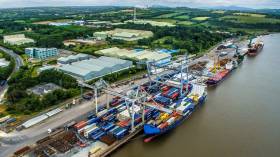Displaying items by tag: Belview Ind Zone
Port of Waterford Study Shows Zone Provides Almost 1,000 Jobs & Turnover Approaching €1bn
#Ports&Shipping - The Port of Waterford have commissioned an economic impact study that shows the Belview Industrial Zone surrounding and including the port (see snapshot) supports 632 full-time jobs directly and a further 348 indirectly, a total of 980.
Last year the 265-hectare zone in south Co Kilkenny generated a turnover of €388m directly and a further €555m through its multiplier effect in the wider economy. Overall this gave an impact of €942.4m.
The Port of Waterford added that the zone’s estimated gross valued added (GVA) last year was more than €190m while the direct regional impact of the Belview Industrial Zone is underlined by a review of those employed within it.
Of 588 personnel reviewed for the study, 317 (54%) live in Waterford, 147 (25%) in Kilkenny and 94 (16%) in Wexford. This makes the Belview Industrial Zone one of the biggest sources of employment across three counties in the southeast with the remainder commuting from counties Tipperary, Laois, Limerick, Kildare and Cork.
The value of goods shipped through the Port annually is estimated at €1.7bn in the 36-page study completed by Raymond Burke Consulting.
Reviewing the sources and destinations for freight transiting Waterford, the report’s authors found the direct impacts of Brexit should be minimal as three-quarters of the Port’s business is with mainland Europe and just 2% with the U.K. Furthermore the Port’s south-east location makes it a good option to facilitate businesses wishing to bypass the UK and provide direct connections with the continent.





























































